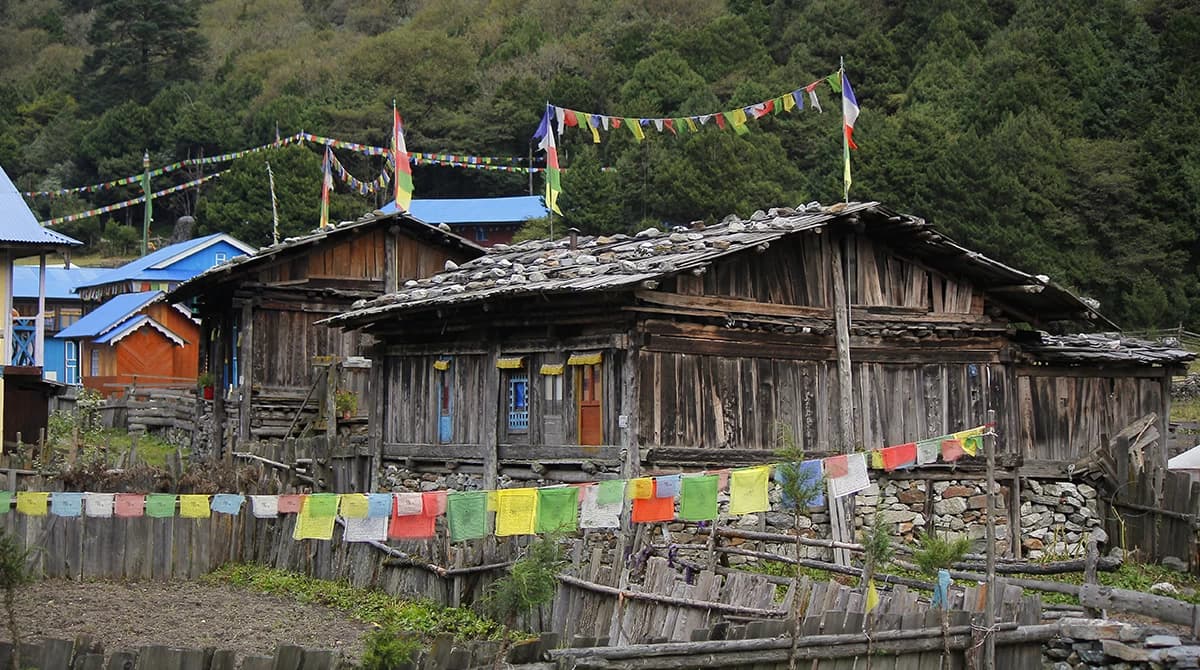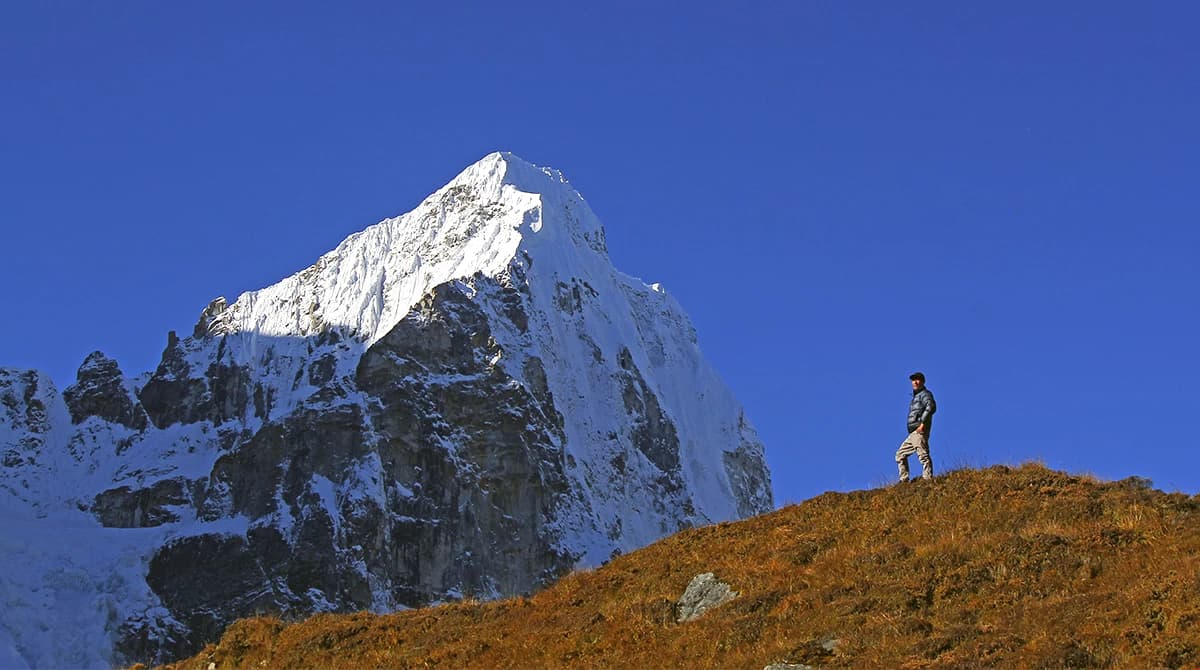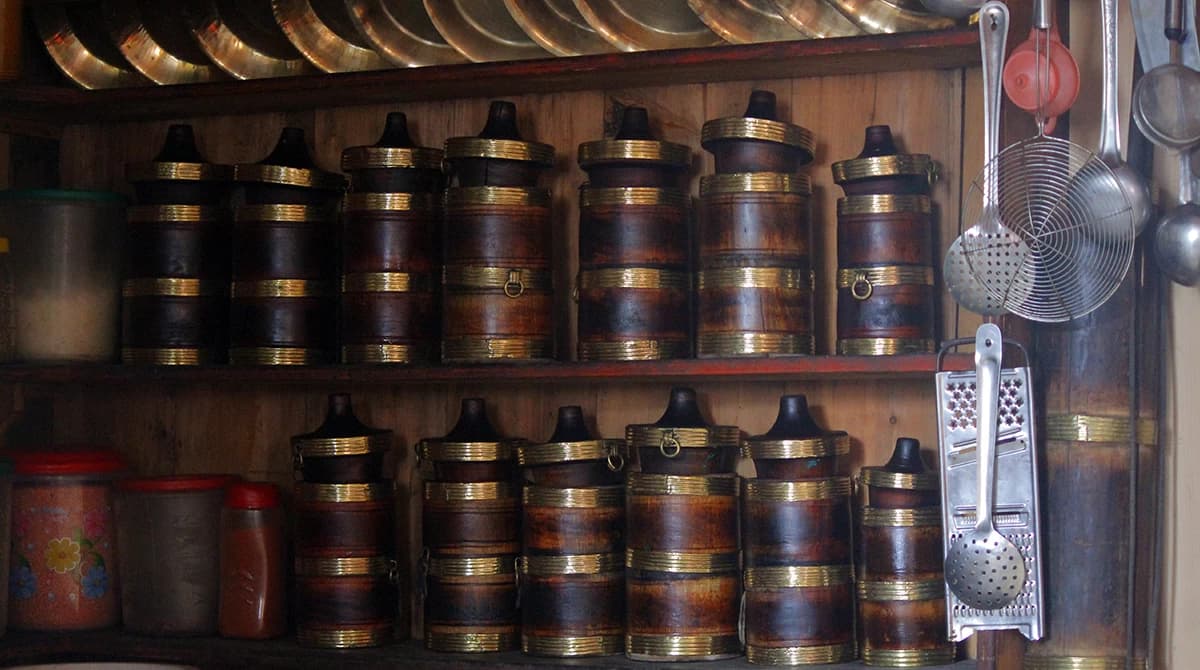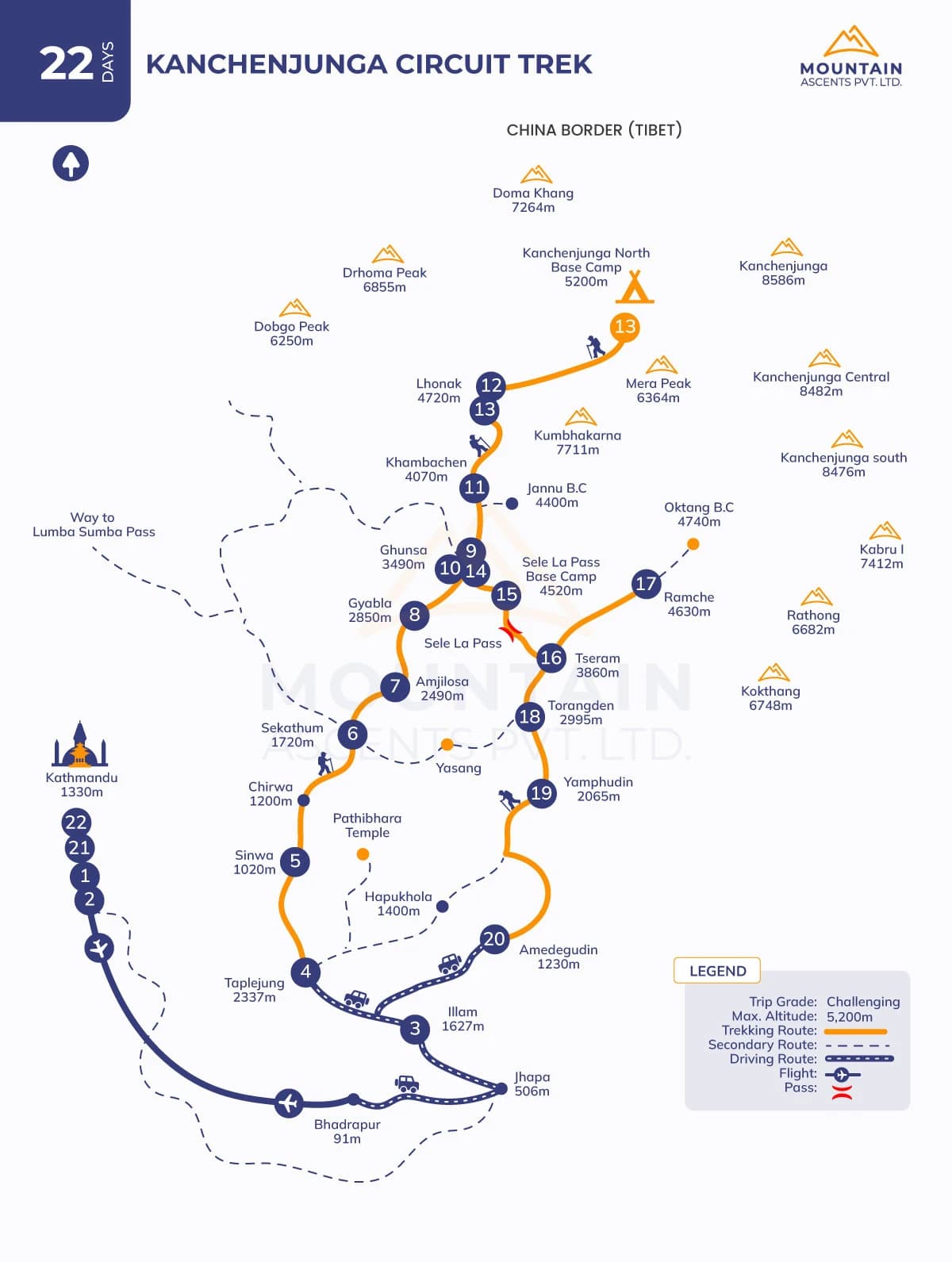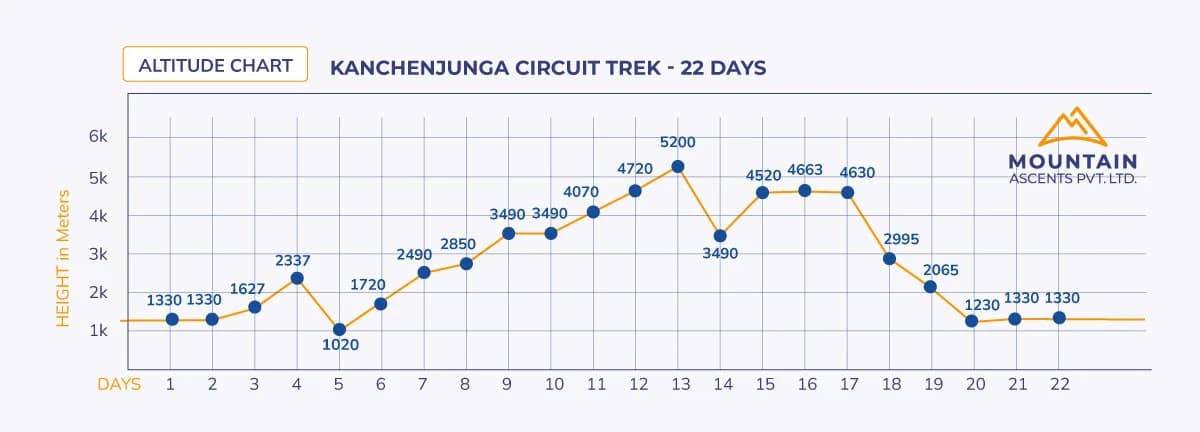The Kanchenjunga Circuit Trek, located in the remote eastern region of Nepal, is a highly adventurous trekking route that explores both the north and south base camps of Kanchenjunga, the world's third-highest mountain at 8,586 m above sea level. Ideal for those with previous high-altitude trekking and climbing experience, the pristine trekking trail offers you an unparalleled adventure in solitude, boasting breathtaking, unspoiled natural beauty and untouched wilderness. This off-the-beaten-Himalayan route passes through lush forests of rhododendrons, remote villages of Rai, Limbus, and other ethnic communities, and high alpine meadows, providing an authentic yet balanced fusion of adventure, cultural immersion, and awe-inspiring mountain views, including that of Kanchenjunga, Jannu, Kabru, and others.
During this Himalayan trip, the Kanchenjunga Circuit Trekking that reaches both of the bases stands out for its complete and unique perspective of the majestic mountain while navigating the rugged trails and diverse landscapes; you will also get to receive an insight into local culture, especially around Ramatang and Oktang Monasteries in the serenity of the Himalayas. It will be an epic experience to make our way through the region’s rich biodiversity, featuring verdant woodlands in the lower land, alpine meadows in between, and high-altitude plateaus dotted with spectacular, thrilling rivers, typical mountain villages, waterfalls, green meadows, and glaciers, not less than five, including Zumu, Talung, and Rathong.
As a recently added route to the Nepalese Himalayan Trekking Map under the Kanchenjunga Conservation Area, which is home to numerous elusive wildlife, including red panda, blue sheep (Bharal), snow leopards, musk deer, Himalayan Tahr, and others, the region stands out as a true Himalayan expedition due to its limited commercial infrastructure, miles away from the bustling crowds of more popular treks like the Everest Base Camp or Annapurna Circuit. Come join Mountain Ascents amid the Himalayas on the Kanchenjunga Circuit Trek; you'll experience air as cool as the blue heavens whose primary objective is to reach Kanchenjunga Base Camp, located at an impressive 5,200 meters, presenting both challenging and rewarding topography for experienced trekkers.
Along a caravan route that passes through Sinwa, Sekathum, and the high-altitude villages of Amjilosha and Gyabla, the trek takes place in the beautiful Taplejung Districts of Nepal’s Eastern Region. You will be met with incredible views of the Kanchenjunga Range as you climb towards Ghunsa and to Khambachen. As you follow in the footsteps of mountaineers like Joe Brown and George Band, who were among the first to reach the peak of Kanchenjunga in 1955, you will be a part of a history that began in 1988, when this area welcomed trekkers from all over the world.
Get ready for an extraordinary journey that will test and delight you as you immerse yourself in Nepalese hospitality's beauty and nature's magnificence on the Kanchenjunga Circuit Trek.
Trip Highlights
- Explore the capital city of Nepal, Kathmandu, home to at least seven of the UNESCO World Heritage Sites, such as Pashupatinath (one of the holiest Hindu temples in the world), Boudhanath (the largest dome in Asia), Swayambhunath (the Monkey Temple), and the other three ancient Durbar Squares (Basantapur, Bhaktapur, and Patan) and Changunarayan Temple.
- Enjoy the equally dramatic flight and drive to Nepal's less traversed eastern mountainous regions.
- Discover the pristine beauty of one of the most remote trekking regions of the Nepalese Himalayas.
- Stunning mountain views, such as that of Jannu (Kumbhkarna) and a few eight thousanders like Makalu (8,485 m, the fifth highest mountain range on the earth) and Everest (8,848 m, the top of the world), while the third-highest peak in the world, Mt. Kanchenjunga (8,586 m), and its various perspectives predominate the sky horizon.
- An opportunity to learn about the distinctive culture, history, and way of life of diverse ethnic groups such as Rai, Limbu, Sherpa, and other Himalayan communities.
- Marvel at the rich biodiversity of the Kanchenjunga Conservation Area, where you may encounter rare species like red pandas, snow leopards, Himalayan black bears, and others.
- Arrive at both of the base camps of the majestic Kanchenjunga mountain peak: North Base Camp (Pangpema) at 5,143 m and South Base Camp (Oktang) at 4,610 m above sea level, which offer otherworldly panoramic views.
- Trek through the varied landscape featuring lush rhododendron forests, alpine meadows, glacial moraine, and serene rivers.
- A spiritual rejuvenation at the Ramtang and Oktang monasteries on the lap of the sky, perching mountain giants.
- An interesting escape from the tourist influx is trekking the trails of Nepal in solitude.
- Make your way through remote villages like Ghunsa, Taplejung, Yamphudin, and others showcasing interesting local lifestyles.
- Make an adventurous ascent to the high-altitude mountain passes, such as Sele La and Mirgin La, with rewarding mountain vistas, etc.
What can you expect during the Kanchenjunga Circuit Trekking?
The Kanchenjunga Circuit Trek in the eastern Himalayan region of Nepal stands out for its remote and unspoiled natural beauty that might have been long lost from some of the more popular trekking routes. The trail takes you through the Kanchenjunga Conservation Area and its restricted land, allowing only a limited number of visitors everywhere due to its cultural and natural sensitivity in proximity to the borders of India and China.
As you traverse through the varying landscapes featuring lush forests, meadows, rivers, waterfalls, and quaint yet beautiful villages of Himalayan locals, eventually leading to the base of the third tallest mountain, you can expect breathtaking scenery, cultural experiences, and the chance to explore the serene wilderness of the Kanchenjunga Conservation Area like never before.
It is essential that trekkers are well prepared for high-altitude trekking conditions, including paving the way through the rugged Himalayan terrain, unpredictable weather conditions, and steep ascends and descends best suited for individuals seeking something extraordinary and a magical venture in the Himalayas. Here are some of the elements that make this Kanchenjunga Circuit Trekking truly an exceptional journey of a lifetime:
Remote, unspoiled, and off-the-beaten Himalayan Trails
The Kanchenjunga Trekking Trail in Nepal is located about 800 km/500 miles east of Kathmandu, It takes about 18-24 hours of driving to reach even the trek starting point in the remote Himalayas. Therefore, unlike more famous treks in the country, such as Everest Base Camp or Annapurna Circuit, this specific trekking route is less traversed, offering solitude without any meddling between you and mother nature at its finest, evoking a true sense of adventure from the very beginning.
During this Himalayan voyage, trekkers will pass through isolated villages of Rai, Limbu, and Tibetan communities inside the less-frequented Kanchenjunga Conservation Area, retaining the real beauty of the Himalayas, nature, and culture. The trails take you through untamed, wild, rugged landscapes, characterized by lush forests, shimmering glacial lakes, and strenuous high mountain passes such as Sele La (4,290 m), allowing an unmatchable sense of achievement, raw nature, and solitude as you gradually ascend to your dream destination at stunning base camps: Pangpema and Oktang.
Alluring views of Kanchenjunga
The Kanchenjunga Circuit Trekking takes a round trip to the third tallest mountain peak in the world, Mt. Kanchenjunga (8,586 m), which once was taken as the highest mountain range in the globe until 1852. Therefore, trekkers are rewarded with unique and varying perspectives of Mount Kanchenjunga each day, making the trek a visual feast that is equally awe-inspiring for all sorts of adventures, including trekkers, mountaineers, or simply nature lovers.
Additionally, trekkers would be rewarded with panoramic views of Jannu (Kumbhakarna) at 7,710 m above sea level, also known as the mystery peak, along with its dramatic ridges and glaciers. Look forward to marveling at the majestic sights of Rathong (6,678m), Kabru (7,412m), and Pandim (6,691m), added to much by the eight-thousanders like Makalu (8,485m) and even Everest (8,848m) on clear days, enhancing the overall beauty of the entire region.
These peaks look extra gratifying from high-altitude landmarks such as Ramtang and Oktang Monastery, Khambachen, high mountain passes like Sele La Pass and Mirgin La Pass, and the Kanchenjunga North and South Base Camps, specifically during sunrise and sunset as you witness the interplay of golden rays of sunlight over the whitewashed, snow-capped mountain peaks.
Experience rich cultural diversity
The Kanchenjunga Circuit Trekking route passes through several villages of the Himalayan locals, which are inhabited by various ethnic communities, including the Rai, Limbu, Sherpas, and other Tibetan communities, offering a rich tapestry of cultural diversity. Interesting to observe would be the daily subsistence activities of Rai and Limbu, who were locally known as Kirantis of Nepal, believed to be an embodiment of nature-worshipping, animism, and shamanism, whereas Sherpa and other Tibetan tribes follow most of the traditions influenced by Tibetan Buddhism. Trekkers in several traditional villages like Taplejung, Ghunsa, Sekathum, and others can enjoy insight into rural Himalayan life, including the genuine hospitality of the locals. Throughout the journey, you will be able to witness the exclusive harmony of Hinduism and Buddhism as represented by several ancient monasteries, gompas, mani walls, and chortens, adding much to the cultural and spiritual dimensions.
Both are located in the heart of the Himalayas, Ramtang Monastery is in proximity to Ramtang Village, and Oktang Monastery is near the Oktang Base Camp, commonly known as Kanchenjunga South Base Camp. These two hold significant cultural and religious values. Situated amidst breathtaking alpine surroundings, both monasteries epitomize the peaceful coexistence of people and nature, steeped in Tibetan Buddhist traditions with prayer flags, mani walls, and stupas that are inheriting cultural importance, especially for Sherpa and Tibetan communities. This provides a very nice atmosphere for trekkers to reflect upon, learn about Buddhist rituals, capture an insider insight into the Himalayan spiritual traditions, and connect with the simple yet enriching lifestyle of locals. These Buddhist landmarks, set against the sweeping backdrop of Kanchenjunga, are spiritual sites that are perfect spots to worship and meditate for both trekkers and locals.
Walk through the diverse ecosystem of the Kanchenjunga Conservation Area
The Kanchenjunga Circuit Trek is one of the six conservation areas of Nepal known as the Kanchenjunga Conservation Area. It covers an area of 2,035 square kilometers with five types of ecosystems, namely the subtropical zone (800m-2,000m), temperate zone (2,000m-3,000m), subalpine zone (3,000-4,000m), alpine zone (4,000m-5,000m), and Arctic zone (above 5,000m), thus providing different opportunities to experience varied flora, fauna, and landscapes.
In the subtropical zone, trekkers will enjoy the warm valleys with lush forests of sal and fig trees, scenic terraced farmlands, and cardamom plantations around Illam, Taplejung, and Sinuwa. On ascending further, you will walk through the forests of oak, pine, and rhododendron, serving as the natural habitat of rare species of red pandas, Himalayan black bears, and satyr tragopan. The subalpine zone is usually barren with sparse vegetation of juniper shrubs and alpine meadows with yaks grazing on it and potential encounters of wildlife like Himalayan tahr and snow pigeons.
Above 4,000m from Khambachen along the Kanchenjunga Circuit Trekking route is an alpine zone promising a visual retreat of glacial rivers, rocky moraines, and expansive meadows. On your lucky day, trekkers may even get to see rare Himalayan wildlife like blue sheep and snow leopards. Once you touch the land above 5,000m, the Arctic Zone, it marks proximity to your main destination, Kanchenjunga North and South Base Camp, characterized by barren, icy, and snowy landscapes topped by towering peaks, snowfields, and high passes.
The diversified ecosystem makes the journey to the Kanchenjunga Circuit more than mountains and high-altitude expeditions, with a profound connection to the natural world and diverse ecological treasures kept in the eastern Himalayas of Nepal.
High-altitude wonderlands of North and South Base Camps, Yalung Glaciers, and mountain passes
The Kanchenjunga Circuit Trek reaches both the North Base Camp of Pangpema and the South Base Camp of Oktang via some high passes, including the Sele La Pass at 4,290 m and Mirgin La at 4,480 m/14,694 ft, giving different perspectives of Kanchenjunga's massive south and north passes along with Yalung Glaciers. Nestled at an altitude of 5,143 m, the Pangpema, the local name of Kanchenjunga North Base Camp, serves as one of the best serene and remote vantage points with gorgeous views of the grandeur of the world’s third highest point, Kanchenjunga.
Similarly, lying at 4,730m above sea level is the Kanchenjunga South Base Camp, offering close-up views of the south face of the relative peak. Cornered by Yalung Glacier and towering Himalayan peaks, also called Oktang, the raw beauty of the glacial landscape and alpine wilderness seen from here is epic, one of a kind, fostering a deep sense of achievement. In the meantime, Yalung Glacier is a dramatic ice wonderland beneath the south face of Mount Kanchenjunga with magnificent ice fields, deep crevasses, and moraine landscapes. This glacier is one of the key attractions to view the raw power and beauty of the Kanchenjunga Massif, worth a hike.
Last but not least, Sele La and Mirgin La Pass are two of the thrilling high-altitude mountain passes that connect the hidden gem of the Kanchenjunga Circuit Trek to its admirers. In the high altitude, these parks offer you sweeping views of the Kanchenjunga Massif and surrounding peaks, including Mount Makalu, Jannu, and even the highest mountain on the earth, Mount Everest (8,848 m), on clear days. Trekkers on these ultimate highlights are rewarded immensely as they are challenged both mentally and physically at a balanced level.
These high-altitude landmarks usually consist of steep ascents, descents, and rugged paths demanding excellent physical fitness, endurance, and determination. The high passes and base camps are often covered in snow and can be icy above 5,000 m with an increased risk of altitude sickness. If symptoms are not taken care of at the time, acute mountain sickness (AMS), commonly known as altitude sickness, can be fatal in remote areas with limited rescue options and basic facilities. The uncertain weather that can drop the temperatures below freezing level makes it taxing; however, it is manageable with proper preparation, acclimatization, and a skilled guide Mountain Ascents are edging it.
Kanchenjunga Circuit Trekking 22 Days Itinerary best route
The 22-day Kanchenjunga Circuit Trek itinerary in the remote Himalayas that also enters one of the highly restricted areas of the country begins with your arrival in Kathmandu, Nepal. In Kathmandu, you will spend two nights and days for better adaptation to the Himalayan air. Trekkers can fully explore Kathmandu, also known as the city of temples, during this time, including some of the UNESCO World Heritage Sites. The official journey begins on the third day with a scenic flight to Bhadrapur and a drive to Illam. The joyous drive ends at Talejung on the fourth day to begin trekking and then onwards.
From Talpejung, you will follow the gradually ascending trail through lush forests, terraced farmlands, and typical mountain settlements of Limbu and Rai, such as Sinwa, Sekathum, Amjilosha, Gyabla, Ghunsa, Khambachen, and Lhonak, eventually making it to the North Base Camp (Pangpema) at an altitude of 5,200 m/17,056 ft, where you will enjoy jaw-dropping views of massive Kanchenjunga’s north face. In between is a buffer day at Ghunsa, essential for recharging and acclimatization before attempting a high-altitude trek above 3,000 m that is prone to acute mountain sickness (AMS) or altitude sickness.
After a successful ascent to the north base camp, trekkers will return to the heart of the Kanchenjunga, Ghunsa, before crossing the challenging Sele La Pass, Mirgin La, and Sinion La to reach Tseram and Ramche before finally heading to the South Kanchenjunga Base Camp. Otherwise also called Oktang, the Kanchenjunga South Base Camp is famous for its stunning views of the mountain’s southern face that you can grasp in your soul and heart by the 17th day based on this Kanchenjunga Circuit Trekking 22 Days Itinerary. Thereafter is a return journey that passes one more time through the traditional villages of the Himalayan locals, such as Tortong, Yamphudin, Amedegudin, Suketar, and lastly Bhadrapur.
These villages with well-established tea houses, lodges, and guest houses opened by locals themselves ensure your comfortable stay, hearty meals, and seamless interactions. Trekkers will experience the warm hospitality of local communities and get to see their authentic culture and traditions. To conclude, this 22-day itinerary for the Kanchenjunga Circuit Trekking offers a perfect fusion of cultural immersion, biodiversity, and high-altitude vistas with ample acclimatization days to prepare oneself mentally, physically, and logistically; hence, it is considered the best Kanchenjunga Trekking Route to must embark on in 2025 and 2026.
Kanchenjunga Circuit Trek 22 Days Cost 2025 and 2026
The Kanchenjunga Circuit Trek cost for 2025 and 2026 can typically range from USD 2,500 to USD 4,000, and more, per person, based on group size, trekking agency, services offered, and any other extra added facilities. At Mountain Ascents, you can get a group discounted price on the Kanchenjunga Circuit Trekking Cost, which includes permits, accommodation, meals, guides, and transportation, including both domestic flights and drives.
Any changes in the standard itinerary do add slightly to the package cost, which also varies from season to season, i.e., it is also slightly more costly to trek during the peak trekking and climbing time in Nepal (spring and autumn), requiring pre-booking teahouses, flights, and permits.
Why Trek with Mountain Ascents?
Mountain Ascents provides a variety of packages to suit different needs, from standard to premium, allowing for a tailored and pleasant journey. Every trekker may count on the unwavering assistance of the team, which will be led by climbing guides with years of extensive experience and extensive qualifications. The company ensures a smooth planning process through the provision of comprehensive documentation, enabling participants to focus exclusively on the planned adventure. Mountain Ascents goes above and beyond to make attaining aspirations a reality, putting in all effort to make each trip memorable and successful.
Our Strengths
- Certified and Experienced Guides
- High Success Rate
- Immersive/authentic experience
- Trek/Climbing Confidence and Highly Motivated Crew
